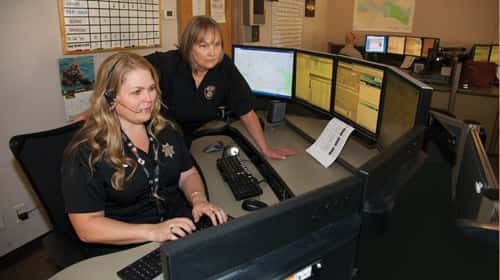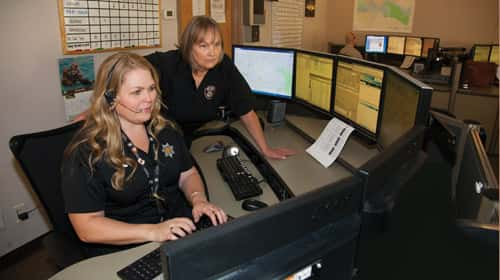
Until there’s an emergency, you don’t give much thought to the trained professionals who work in our local dispatch centers. Dial 9-1-1 in the North Bay and you can count on reaching a highly-skilled dispatcher who will calmly and thoroughly take your information and arrange for help. More often than not, that dispatcher is a woman.
During the frantic hours when the Tubbs and Atlas fires tore through Sonoma and Napa counties, thousands of calls were fielded and help was dispatched from three emergency communication centers. Women handled most of these calls because the majority of dispatchers and call takers are women.
At the Sonoma County Sheriff’s Dispatch Bureau, located in the county administration center, 78 percent of dispatchers are women. Of the 24 positions at the Santa Rosa Police Department’s 9-1-1 Communications Center, women occupy 17. Napa’s 9-1-1 Dispatch Center in downtown Napa currently employs only one man as a dispatcher; women hold the remaining 20-plus positions.
Nobody can say precisely why women significantly outnumber men in the job in the North Bay, but there are many theories.
Multifunctional dexterity
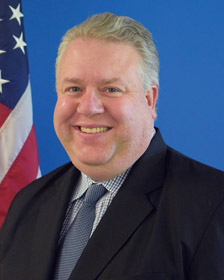 “Women tend to have a more caring and nurturing aspect,” says Gus Ulloth, communications manager for Napa 9-1-1. “There’s no scientific data why women seem to fill these jobs more than men, but it does require a certain type of personality.”
“Women tend to have a more caring and nurturing aspect,” says Gus Ulloth, communications manager for Napa 9-1-1. “There’s no scientific data why women seem to fill these jobs more than men, but it does require a certain type of personality.”
Ulloth likens it to the ‘women are from Venus, men are from Mars’ dichotomy. He says the staff witnesses it occasionally when a dispatcher is trying to take control of a conversation with a difficult caller. “To get the information we need, the dispatcher can put on her ‘mom’ voice, like when a misbehaving child hears his mother’s voice and then does what he is told to do. We tend to joke about it, but there’s something to that.”
The average citizen might not realize what an emergency dispatcher’s job entails, says Don Jones, manager for Sonoma County Sheriff’s dispatch bureau. “They may think it’s sitting in front of a computer answering the phone. But it’s having more than 60 lines to answer and monitoring all of the Sheriff’s deputies driving around the county, among many other duties. The job of a dispatcher is one of extremes. A dispatcher must speak calmly to someone with a gun to his head, and the next call taken might be a barking dog complaint.”
Jones refers to it as “multifunctional dexterity”––the ability to hear information, communicate new information to the caller, and enter other relevant information into the computer simultaneously. What’s more, a dispatcher must ask all the right questions, and she has to also hear what’s not being said, and listen to noises in the background. “She has to retain a lot of information, document it, listen carefully, type the data into the system, and continue speaking to the caller, all at once.”
Better listeners
A caretaking personality is also an asset, says Jones. “All of these dispatchers are really caregivers because they want to help people as best they can. The average dispatcher nationwide is in the job for seven years, but we are fortunate that our staff average is almost double that.”
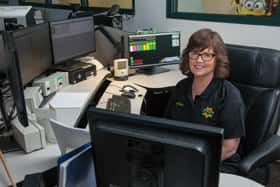 In fact, one of the dispatchers for Sonoma County has been in the job 28 years. Colleen Doherty initially was attracted to the shift work. “I’d done an internship at juvenile hall but didn’t want to be a probation officer. My husband already worked for the Sheriff’s department, and I liked law enforcement. After our second son was born, we worked opposite shifts so our kids wouldn’t need daycare.”
In fact, one of the dispatchers for Sonoma County has been in the job 28 years. Colleen Doherty initially was attracted to the shift work. “I’d done an internship at juvenile hall but didn’t want to be a probation officer. My husband already worked for the Sheriff’s department, and I liked law enforcement. After our second son was born, we worked opposite shifts so our kids wouldn’t need daycare.”
The pay, she adds, was also excellent for a woman in the early 1990s. “I had been working 40 hours a week at a bank, but as a dispatcher I made three times as much.” In California, dispatcher jobs pay well compared to many other parts of the nation, with a Sonoma County Sheriff’s trainee able to earn from $55,000 to $60,000 annually, and a fully trained, seasoned dispatcher taking home $72,000, not including overtime.
“Dispatching is a multitasking, high pace job. One minute you’re going a hundred miles an hour and the next minute it’s all quiet,” says Doherty. Women, she believes, are just better listeners than men, too. “I don’t want to offend men, but I’ve lived in a houseful and they listen differently. When we take a call, we’re not only listening to what the caller is saying, but how they are saying it, trying to gauge the mannerisms in their voice. Sometimes, a woman can do that faster.”
A commanding presence
Women have historically dominated the dispatch profession, according to Becky Abrams, public safety dispatch supervisor for Napa 9-1-1. “It wasn’t considered much of a career 30 years ago––it was a job, more like secretarial work. Today, the professionalism of dispatchers is greater in California than many other states.”
Abrams says she is “a complete anomaly,” having been a dispatcher for 33 years. “Many women struggle with managing the work-life balance, especially with motherhood. When our children were young, my husband was a deputy Sheriff and I was working dispatch at night. Arranging childcare for 3 a.m. is difficult.”
One barrier to becoming a dispatcher for a lot of men, especially in the early days of the profession, she says, was the typing requirement of 40 words per minute. “Men struggled with that because they typically didn’t have job experience where typing skills were required. As digital and keyboarding skills became mainstream, more men entered the field. Dispatching has become more technically advanced, attracting a more diverse group of applicants. Some use dispatching as a steppingstone into fieldwork. Many jurisdictions give candidates with dispatch experience preference for promotion in field unit positions such as for being a police officer or firefighter. If you already had experience being a dispatcher, you could get preference to move into police and fire positions. The knowledge bases are similar, and you have to know a lot about law enforcement to successfully perform this job.”
While women and men may be equally adept in the electronic world of dispatching, the emotional component is sometimes more satisfying for women, says Abrams. “When someone tells a woman ‘I have a problem,’ we want to help with that problem. And yes, there is that ‘mom’ voice component. This job in general commands a presence, and all we have is our voice. We have to be able to break through a caller’s mental illness issues, for instance, so they can tell us what’s going on.”
Coaching callers to perform CPR is also vital. “We are very assertive at helping frantic people start early CPR,” says Abrams. “We walk them through it with absolute certainty that we know what we’re doing and are here to help them.”
Fulfilling, but tough
Training to become a dispatcher is not for the faint-hearted. It generally requires working a full year as a trainee to learn all the skills needed. If at one time it was considered little more than secretarial work, now it’s more like sitting in the cockpit of a jumbo jet.
“It’s an insane amount of information they have to learn, and the multitasking is on a level that’s intense for most people,” explains Casey O’Connor, communications supervisor for the Santa Rosa Police Department’s 9-1-1 Communications Center. “There’s so much to know and learn for a trainee to become even halfway competent at it. Callers yell at you, and it’s a lot of negativity to deal with. You must have the mental desire to be successful at it.”
O’Connor doesn’t believe women have an innate advantage over men in the profession, but she does notice that women dispatchers tend to be more empathetic on the phone. “But that has more to do with how they approach the job and not so much their gender. If anything, women may have to work a little harder at it to overcome some societal biases. Most of the time, though, people calling in a panic don’t care if they are talking to a woman or a man.”
Emergency dispatching is a worthwhile and fulfilling profession, says O’Connor. “But it’s tough, too.”
Jones says most law enforcement officers in the field know how valuable dispatchers are, even if they wouldn’t want to be one. “I would argue that dispatchers are the first first responders, but we aren’t considered first responders at the federal level. Instead, we’re classified in the same category as tow truck dispatchers.”
A comforting voice
Meghan Dixon worked security dispatch on the Santa Cruz Beach Boardwalk when she was younger. “My father and grandfather were police officers, and when the opportunity came open for me to get into law enforcement, I took it.” She’s been an emergency dispatcher for the Santa Rosa Police Department for nearly two years, with 12 years of experience altogether.
“When people call, I try to be a comforting voice. I don’t know that a woman’s voice is more calming, but women tend to be better communicators. It’s often said that women tend to be more nurturing and comforting in their approach, and that plays a part.” Why do more women than men go into the field of dispatching? “If there is an interest in law enforcement, I believe men gravitate more toward the patrol side,” she adds.
Dispatching, says Dixon, is the best alternative to being in law enforcement without wearing a badge and packing a gun. “I pride myself on giving the best service and interaction I can, and that’s reassuring to me. I’m good at dispatching, and I’m sticking with it. I don’t see myself doing anything else.”
the First first responders
Driving north from American Canyon, Becky Abrams saw the glow of the early hours of the Atlas fire on her way to downtown Napa. “If I could see it from all the way down there, I knew it wasn’t good,” says the public safety dispatch supervisor at the Napa 9-1-1 Dispatch Center. “When I arrived at work for a scheduled overtime, I walked into complete bedlam.”
Women dispatchers who answered emergency calls during the Atlas and Tubbs fires recall it was like no other shift before.
Meghan Dixon, an emergency dispatcher at the Santa Rosa Police Department’s 9-1-1 Communications Center, remembers that night as “the most intense, most emotionally draining of my career. It tapped into every skill and every bit of training I’ve ever had.”
Many of the calls Dixon fielded were from people who could see and smell smoke and wondered how to evacuate. “The calls began with people asking where they should go, and then it progressively turned into more rescue calls. I talked to one woman whose power was out and she couldn’t get out of her garage. Another woman said she was elderly and blind.”
“Some of our callers were in disbelief,” says Casey O’Connor, communications supervisor for the city’s 9-1-1 center. “Some needed medical attention, and some were terrified because someone was pounding on their door telling them to evacuate. Many callers just wanted to know what was happening.”
O’Connor, Dixon and the other police dispatchers had to explain to callers that if they felt unsafe, they needed to leave their homes. “We said if you see fire next door, get out of your house and do what feels safe. We couldn’t tell them how to escape because we couldn’t see their circumstances, and we might send them in the wrong direction.”
With almost 30 years of dispatching experience, Colleen Doherty thought she’d heard everything. But the dispatcher for the Sonoma County Sheriff’s Dispatch Bureau called the Tubbs fire event “like nothing I’d ever encountered in my life, and I’ve worked some crazy busy events.”
While many callers wanted to know which way the fire was going and where they could find an evacuation center, Doherty also spoke with one persistent woman who called repeatedly throughout her shift, inquiring about her neighbors. She feared they hadn’t made it out of their house, and she wanted Doherty to confirm it. “I finally let the woman know that, yes, two bodies had been recovered from the house. Later on she called again asking about the deceased neighbors’ dog: ‘Could the dog also be dead?’ It was hard to be so frank, as that’s not how we handle these types of notifications. However, the woman was hurting, and she was going to be made to wonder for days. I couldn’t do that to her.”
“Truthfully, we expected more people to die, and we had a channel dedicated just for body recovery. As tragic as the deaths were, we were relieved when the death toll was much, much lower than we feared it might be.”
Abrams, a dispatcher for 33 years, routinely tells callers needing assistance that help is on the way. But as the Atlas, Tubbs and Partrick fires burned simultaneously in Napa Valley, it wasn’t always possible. “We couldn’t assure people that someone was coming to help. That goes totally against everything we do, and it was a source of stress for many of us.”
The october firestorm: 9-1-1 callers
At the Sonoma County Sheriff’s Dispatch Bureau:
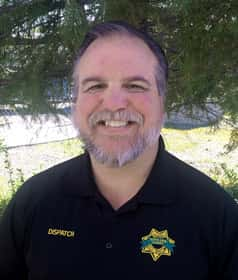 A typical Monday at the county’s dispatch bureau might include answering 74 9-1-1 calls and 415 7-digit emergency calls.* Those were the number of calls the bureau handled on October 2, 2017. A week later, as the Tubbs fire raged, the call volume increased almost six-fold. On October 9, dispatchers answered 913 9-1-1 calls and 1,948 7-digit calls.
A typical Monday at the county’s dispatch bureau might include answering 74 9-1-1 calls and 415 7-digit emergency calls.* Those were the number of calls the bureau handled on October 2, 2017. A week later, as the Tubbs fire raged, the call volume increased almost six-fold. On October 9, dispatchers answered 913 9-1-1 calls and 1,948 7-digit calls.
“We took 707 9-1-1 calls from midnight until 4:49 a.m. on October 9,” explains Don Jones, dispatch manager for the county. “The [Tubbs fire] event for us started around 10 p.m. on October 8, when we took 70 9-1-1 calls and 130 7-digit calls. An hour later, we had 162 9-1-1 calls and 280 7-digit calls.”
The bureau had five dispatchers and one supervisor on duty when the Tubbs fire broke out, and additional staff arrived after midnight, says Jones. “The national standard is to answer all 9-1-1 calls within 15 seconds, 90 percent of the time. On October 9, we answered our 9-1-1 calls within 20 seconds, 95 percent of the time, with limited staffing. We rocked it.”
At the Santa Rosa Police Department’s 9-1-1 Communications Center:
The center fielded 4,001 calls between 9 p.m. on October 8 and 9 a.m. on October 9. For the 24 hours between 9 p.m. (October 8) and 9 p.m. (October 9), the center handled 6,890 calls.
By contrast, the center processed 4,324 emergency calls for the seven days between October 1 and October 7. During the Tubbs fire event, it handled nearly that amount in one 13-hour period. “We were fortunate to be heavily staffed in the center that night, just by coincidence,” explains Keith Hinton, technical services division manager for the Santa Rosa Police Department. “It was tense, but we were humming along.”
At the Napa 9-1-1 Dispatch Center:
The center fielded 935 calls on its emergency lines (9-1-1 and 7-digit) on October 8, with the busiest hour at 10 p.m. (257 calls). On October 9, the center answered 890 calls, and on October 10 it handled 340 calls.
“A normal day for us is between 120 and 175 emergency calls,” says Gus Ulloth, communications manager for the center. Ulloth’s staff had to contend with calls coming in about three major fires––the Atlas and Tubbs fires, together with the Partrick fire that broke out on the west side of Napa Valley.
“October 8 had already been a busy day for our center,” adds Ulloth. “We had a lot of calls about a smoky fire at an auto recycling facility in American Canyon. Then there was a collision between the Wine Train and a limousine. By 8:40 p.m., we started getting calls about a fire near Silverado Resort, and it just took off from there.”
*7-digit emergency calls ring directly into the dispatch bureau from the alternative emergency line, (707) 565-2121. After hours, the bureau also answers the non-emergency lines that would normally be answered by the department’s front desk.
Author
-

Jean Doppenberg is a lifelong journalist and the author of three guidebooks to Wine Country.
View all posts


